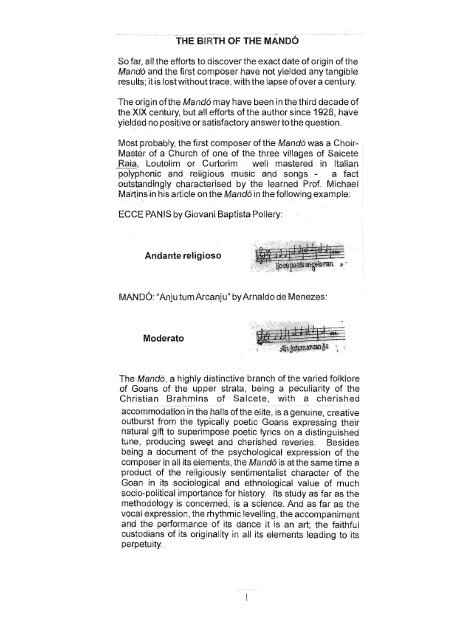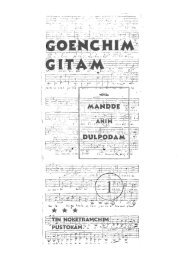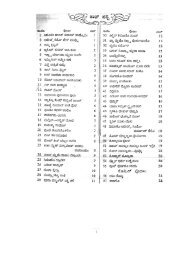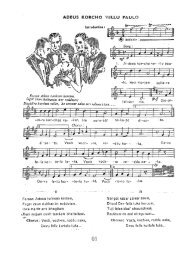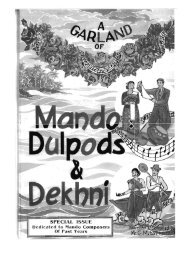Booklet - Songs from Goa
Booklet - Songs from Goa
Booklet - Songs from Goa
You also want an ePaper? Increase the reach of your titles
YUMPU automatically turns print PDFs into web optimized ePapers that Google loves.
THE BIRTH OF THE MANOO <br />
Sofar, all the efforts to discover the exact date of origin of the<br />
Mand6 and the first composer have not yielded any tangible<br />
results; it is lost without trace, with the lapse ofover a century.<br />
The origin ofthe Mand6 may have been in the third decade of<br />
theXIX century, but all efforts of the author since 1928, have<br />
yielded no positive or satisfactory answer to the question.<br />
Mostprobably, the first composer ofthe Mand6 was a Choir<br />
Master of a Church of one of the three villages of Salcete<br />
Raia, Loutolim or Curtorim · well mastered . in Italian<br />
polyphonic and . religious music and · .$ongs - a fact<br />
otitstandi'ngly characterised by the learned Prof. Michael<br />
Martins:in his article on the Mand6 in the following example:<br />
. I',' .<br />
ECCE PANIS by Giovani Baptista Pollery:<br />
Andante religioso<br />
MAN06: "Anju tumArcanju" by Arnaldo de Menezes:<br />
Moderato<br />
The Mand6, a highly distinctive branch of the varied folklore<br />
of <strong>Goa</strong>ns of the upper strata, being a peculiarity of the<br />
Christian Brahmins of Salcete, with a cherished<br />
--- _.<br />
accommodation in the halls ofthe elite, is a genuine, creative<br />
outburst <strong>from</strong> the typically poetic <strong>Goa</strong>ns expressing their<br />
natural g.ift to superimpose poetic lyrics on a distinguished<br />
tune, producing swe~t and cherished reveries. Besides<br />
being a document of the psychological expression of the<br />
composer in all its elements, the Mand6 is at the same time a<br />
product of the religiously sentimentalist character of the<br />
<strong>Goa</strong>n in its sociological and ethnological value of much<br />
socio-political importance for history. Its study as far as the<br />
methodology is concerned, is a science. And as far as the<br />
vocal expression, the rhythmic levelling, the accompaniment<br />
and the performance of its dance it is an art; the faithful<br />
custodians of its originality in a/l its elements leading to its<br />
perpetuity.
As the proverb says, "Use time well while time lasts, because<br />
all time is npt time when time has past." The true lovers and<br />
enthusiasts of the precious legacy of our ancestors should<br />
not waste time or slacken their efforts to obtain the needed<br />
elements <strong>from</strong> the existing custodians of the past<br />
generations nearing the end oftheir pilgrimage to the world.<br />
* * * <br />
----- -------<br />
. THE ESSENCE OF THE MANOO<br />
,In the very beginning, the MAN 0 6 has been the biography<br />
of the heart of the composer, a- bursting outcome of the<br />
innermost feelings of love for a certain person ofthe opposite<br />
sex, expressed by the heartfelt poetic narration,<br />
superimposed on a sweet and melodious tune of his own<br />
inspiration modelled on the subject of his exposition. Love,<br />
as such was exposed according · to predominating<br />
circumstances, in all its different forms, moods, means,<br />
ways, turns, expedients and so on. So also the fondness, .<br />
the acquaintances; the approaches, the companionship, the<br />
reciprocation, the unions, the betrayals, the frustrations; the<br />
separations, the sorrowful endings, the hatred and all the<br />
other facts emanating <strong>from</strong> the actions of either of the<br />
parties, either by their own free will or by the despotism ofthe<br />
parents and family members or due to any unpredictable<br />
incident leading to . eventual misfortune all of these are<br />
joyfully or sorrowfully described in all the steps and degrees<br />
of the Mand6, with its peculiar descriptive sense' and<br />
uncanny insight.<br />
As (the late) Prof. Lucio Rodrig ues very well said in his article<br />
"The MAN DO" (Souvenir of the 2nd Mand6 Festival, 1966)<br />
"The composers of the Mand6, though well-acquainted with<br />
the social habits of Western life and well versed in Western<br />
music and foreign languages found it difficult to sing of their<br />
love and the most intimate emotional feelings of the heart,<br />
their life and family through a foreign language and music.<br />
But through the language of their heart - their mother-tongue<br />
Konkani they found it expressive to fix the pattern and<br />
rhythm of the tune, to the pattern and rhythm of the<br />
language."<br />
Note: The plural of Mand6 in Konkani is Mandt;<br />
- - ---------<br />
(In European languages, the double D is eliminated and for<br />
the plural, one S is added.) . .<br />
2
The main features of the MANOO are:<br />
1) The exact idea of the event.<br />
2) The capture of the timely inspiration forthe purpose of<br />
description<br />
3) The free expression to describe the innermost<br />
feelings with due sentimentality<br />
4) The proper care to safeguard the adequate sequence<br />
of the event<br />
5) The choice of a few and proper words disclosing the<br />
full event<br />
6) The knack to adjust the melody to express the due<br />
sentimental sense ofthe lyrics<br />
7) The virtue to expose the due flavour to the expression<br />
fusing the lyrics to the melody.<br />
A Manda is usually in three verses of four lines each or two<br />
stanzas, with the estrebilho oftwo more lines or one stanza to<br />
all the three verses separate to each of them, though there<br />
exist many with more than three verses offour or more lines<br />
with estrebilho also of two or more lines each.<br />
All the Mande display ample opportunity to a captivated<br />
writer to exhibit his ability And turn each and every Manda<br />
into romantic novels of captivating exhilaration.<br />
In many Mande, the composers themselves have<br />
personified their beloved ones to express their aspirations,<br />
feelings, moods and actions or have written in the third<br />
person of their good or bad luck in love, in the family, in<br />
society, gradually sliding down to take a turn to express any<br />
unusual event in social and professional leads, in political<br />
trends, in living standards and in unusual innovations and so<br />
- -=-=-=----<br />
on - psychological, sociological, political, ethnological and<br />
ontological in its nature as we find them today.<br />
3
-..,,~~ ~~----~ ----------<br />
THE.ETYMOLOGY OF THE WORD MANDO <br />
Since no composer has left behind any codification of the<br />
outstanding features and the blending charm of the Mand6<br />
which came to us <strong>from</strong> our ancestors through oral traditions,<br />
the opinions about the etymology of the word Mand6 differ<br />
greatly.<br />
According to the traditional interpretation coming down<br />
verbally through the ages, our ancestors had defined Mand6<br />
as derived <strong>from</strong> the Konkani words "Madd" (standing or<br />
sitting together to see some outstanding display) and<br />
"Manddop" (to be or to keep in order for a definite purpose).<br />
This seems to be true as in times gone by, the Mand6 was a<br />
"must" for a bride on her wedding day and all the guests, the<br />
inmates of the house without exception used to sit attentively<br />
all around the hall in an orderly man ner so as to be able to see<br />
her singing and to hear her voice as well as the expresslycomposed<br />
lyrics and to have a full view of the bride and the<br />
musical accompaniments. These two closely related words<br />
Mandd and Manddop seem to have given birth to the word<br />
Mand6.<br />
Another opinion seeks to attribute the origin of the word<br />
Mand6 to the Hindi words "madhya laya pada" or "madhya<br />
pada" or simply "madhya", based on their meaning '<strong>Songs</strong> of<br />
slow movements'. But this seems to be out of context<br />
because the Mand6 was born in <strong>Goa</strong> among the Konkani<br />
speaking Catholic elite who knew no Indian language other<br />
than their mother tongue. Being so, it is entirely meaningless<br />
that they should use Hindi words for something they created<br />
in their own mother tongue.<br />
The third opinion is that the word Mand6 may have been<br />
derived <strong>from</strong> the Portuguese word "Mando" (an order or<br />
command) for right <strong>from</strong> the beginning, the Mand6 has been<br />
an obligation for. the brides to sing on. their wedding day,<br />
according to the habit among Catholic Elite.<br />
4
---------------- --- -----<br />
THE LYRICS OF THE MANDE ARE RHYMED METRICAL <br />
POEMS <br />
It has been already stated that the lyrics are composed of<br />
poems of three verses offour lines each or two stanzas, with<br />
two more lines or one more stanza for the estrebilho, though<br />
there exist many with more than three verses of four or more<br />
lines each and estrebilho too of more than two lines.<br />
Each of the four or more lines of the verses of the lyrics are<br />
conveniently arranged for the given rhyme atthe end, as weil l<br />
as for the two or more lines of the estrebilho, but there are<br />
some exceptions too ofthe lyrics rhymed to stanza instead of<br />
to each Iline and also one or two lines of the verses out of<br />
rhyme.<br />
As has been said, the study of the Mand6 (also called<br />
mandology) , comprises a combination of science and art. It<br />
is noteworthy that in a majority of the Mande each of the four<br />
lines of the verses carries a definite number of syllables <br />
generally _eight in number though the exceptions are not<br />
uncommon even for classical ones due to the essential<br />
words used to express the sentimentality being unsuitable for<br />
shortening, a fact that necessitates a rise in the number of<br />
syllables to nine or ten or more per line in between the verse.<br />
The estrebilhos generally carry more than eight syllables to<br />
one or both the lines, depending on the expressions<br />
expressed in the estrebilho that usually carries double<br />
repetition by all the assistants after it is sung by the "Duo".<br />
As far as the poetic structure is concerned and having in view<br />
the psycho-etymological factors for the measure of the<br />
syllables in conjunction with the sentimental expression and<br />
the time-signature used by the composer for the melodicoharmonical<br />
rhythm of the Mand6, Mande can be divided into<br />
two groups orforms:<br />
a) STANDARD FORM- With verses of eight syllables to each<br />
line as for example:<br />
Sonv'rach' ollok' aili maka<br />
Sonvsar naka mure maka<br />
Devan dovoll' kiteak maka<br />
Evei dukach' mujea tempa<br />
(8)<br />
(8)<br />
(8)<br />
(8)<br />
I knownowwhatthe World is<br />
And now I don't want this world<br />
Why have you kept me<br />
Lord?<br />
Atthis, thetimeofmyaffliction<br />
alive,<br />
Dotoralem kazar mhunnum<br />
Danvum ailim ratri ratri<br />
Vatter oklanchi bobatti<br />
Apnnank keli mhunnum fatti<br />
(8)<br />
(8)<br />
For the doctor's wedding<br />
I came running at nightfall<br />
(8) On the way I heard brides shouting<br />
(8) That they were despised forever<br />
5
- - ----<br />
b)NON-STANDARD FORM With verses of more or less<br />
number ofsyllables to one ortwo more lines, for example:<br />
Surian uzvadd fankarailo (8) The sun threw it light around<br />
Noketrancho prozoll porean podlo (10) The glare of the starts have<br />
vanished<br />
Kazrach' sakramentu guetlo (8) We have received the Sacrament<br />
Of Matrimony<br />
Am'cho ekvott mure zalo (8) Our union has been achieved <br />
Tuzo mogu maka mhunnum (8) That your fove is really for me <br />
Porgottola sogloch' ganvum (8) Is known all overthe village <br />
Kallizache guto tujerdhovorunum (12) Letting the secrets of my heart <br />
Weigh upon me <br />
Atam vall'ttek pavlam aum (8) I have come to my end <br />
Soglench.' mujem vido chintunum<br />
Dukam golloit' aum<br />
Sonvsarant maka nam re khonnum<br />
Divnchea' buzavonnum<br />
(9) Contemplating the whole of <br />
my life <br />
(6) I sense a continuous welling <br />
Of tears <br />
(8) There is no one in the world <br />
(6) that can console me <br />
These few examples are sufficient to give a proper idea<br />
ofthe poetical structure of both the groups.<br />
c)Examples of Mandewith morethan four lines to each verse:<br />
Zob'bori asloli maka re foxi<br />
Kedon kai sarkeak tujea choichi<br />
Viajik than ailo tum moga<br />
Gopanttujea gue re maka<br />
It was my earnest wish<br />
To glance upon your<br />
features as soon<br />
As possible<br />
you are back <strong>from</strong><br />
your voyage, my love<br />
Now, hold me in your<br />
Arms<br />
Muzo mog tum kedinch visrunk naka Neverforget my love<br />
for you<br />
Tujea utrari re patievnum<br />
Aji than ankvar ravlim aum<br />
. Tun ingrat kiteak zavnum<br />
Maka vetai re sanddunum<br />
Roddtam muzo fuddar re<br />
Chintunum<br />
6 <br />
Relying upon your word<br />
I remained unmarried this<br />
long<br />
Why are you being so<br />
ungrateful<br />
And leaving me now<br />
I nowthinkaboutmy<br />
future and cry
There are some Mande in the form of "Duets" expressing<br />
personification of two different persons objectively involved<br />
In an event. In some, the first stanza depicts the feelings<br />
Of one person, while the second stanza manifests the<br />
Answer to it with sentimentalist expression either accepting<br />
Or contradicting with the views of the first person as to the<br />
subject referred to by him/her, as for example:<br />
Duve, muje duve<br />
Kazar korcheak<br />
Novro sodila tuka<br />
To muj' dolle mukari naka<br />
Kaza zat'rich'<br />
Apttun marta I' maka<br />
Daughter, my daughter<br />
To marry you off<br />
I have chosen a groom<br />
I don't want him within my sight<br />
After he marries me<br />
He will throw me to the ground<br />
and kill me<br />
Sometimes the whole verse of the two stanzas is answered<br />
by the person to whom the same refers, in the whole stanza<br />
of the estrebilho as follows:<br />
Kurtoreantum fulol' fulo<br />
Mainnem tolleakodde g horo<br />
Bai tuk' soiriko sodunko<br />
Anvem maddoile dongoro<br />
Maim aum zaina kazaro<br />
Amigam bogoro<br />
Aflower has blossomed in Curtorim<br />
Ata house near the Maina Lake<br />
Girl, to seek a match for you<br />
I have scaled up and down<br />
The mountains<br />
Mother I don't want to marry<br />
Outside my group offriends<br />
In some, both the stanzas of the first verse are answered<br />
By the person concerned, by both stanzas of the second<br />
verse, as follows:<br />
Tambdde rozad tuje pole<br />
Your cheeks are rosy red<br />
Dukani borle muje dolle<br />
My-eyes are filled with tears<br />
Papache' licens assa zalear polle Askyourfatherifhe permits you -<br />
Kazar zavncheak m u kekodde To marry me<br />
- --.<br />
Papach' licens as re maka<br />
Kazar zavnchea' reavtam tuka<br />
I have my father's permission<br />
I am waiting for you to marry me<br />
Tum tor kazar zaina zalear<br />
Muzo jiv ditol' tuka<br />
- Should you refuse to marry me<br />
I will end my lifeforyou<br />
Many other instances of variations could be given but a<br />
person with a keen interest can easily detect them<br />
<strong>from</strong> the poetic sequence ofthe lyrics.<br />
7
---------- -----~---<br />
THE ESTREBILHOS<br />
The estrebilhos are almost always irregular in metrical<br />
measures or syllables, for example:<br />
10, io gopantulea anja (8) Come, come angel of my bosom<br />
Ekuch' pun bejju di re maka (9) Give me one, just one kiss<br />
Khorench' utor dilear maka (8) If you give me your word<br />
At~paim zoruovn feliz kortol' tuka (10) I will do my best to always<br />
keep you happy<br />
There are some with equal number of syllables to both the<br />
lines of the stanza, for example:<br />
Moga mujer gali dol Ie (8) My love, turn your eyes towards me<br />
Kit' aum bhoguitam tem polle (8) So you can see how I suffer<br />
d)Yet some others have adopted the '4th beat' for the start,<br />
as for example:<br />
Doni tini vorsam zalim<br />
Tuzo mogu keleari<br />
etc.<br />
It has been two Or three years now<br />
Since I have been in love with you<br />
etc<br />
e)And many 0 thers have adopted the '6th beat' forthe start,<br />
asin:<br />
Sangatu moga tuzo<br />
etc.<br />
Your companionship, my love<br />
Etc.<br />
ALL THE MANDDE PROGRESS INTO TWO <br />
WELL-DEFINED FORMS <br />
1) The Simple Form: This form was followed by<br />
composers of the olden times comprising of verses of two<br />
stanzas, both subject to repetition by the "Duo", as for<br />
example:<br />
Mainchea-Paichea moreantulim From the arms of my mother and father<br />
Aichean bhairi aum sorlim Today, I walk away<br />
etc.<br />
etc.<br />
2) The Classical Form: This was followed by almost all<br />
the improved composers and comprised of verses of two<br />
stanzas repeated by the "Duo" as above, with the addition of<br />
the third stanza for the estrebilho that is subsequently sung<br />
repeatedly twice by the chorus after being sung by the "Duo".<br />
The stanzas may be in "Minor Mode" for the first one and in<br />
the "Major Mode" for the second one or vice-versa or both the<br />
stanzas in the s~me mode or only one line of any of the<br />
stanzas in "Minor Mode", the third one being the estrebilho,<br />
almost always in "Major Mode", for example:<br />
8
------,--~ --------<br />
a)Suria noketran porim porzolleta You shine like the sun and the stars<br />
Etc.<br />
etc.<br />
Note:- Only the first stanza is in the "Minor Mode"<br />
b) Kalliz bhettoilolea anjea<br />
Tristez kitea' tum boguita<br />
Etc.<br />
Angel of my surrendered heart<br />
Why are you brooding over sorrows<br />
Etc.<br />
Note:- Only the second stanza is in the "Minor Mode"<br />
c)Bolkanvari re boissotam<br />
etc.<br />
Note:- The whole verse is in the "Major Mode"<br />
-----<br />
I sit on the balcony<br />
etc.<br />
d) Eko vorso bollanddolem One year has gone by <br />
etc.<br />
etc. <br />
Note:- The whole verse is in the "Minor Mode" <br />
THE MEASURE OF THE MANDO AND ITS <br />
TIME-SIGNATURE <br />
There is no doubt that the Mand6 is a regional song invented<br />
by the intellectual capacities of <strong>Goa</strong>ns, but it is unfortunate to<br />
realize that the composers of such a precious legacy of<br />
classical folk music never gave a definite and systematic<br />
measure to their much-admired compositions. This is a fact<br />
that till date gives rise to ideological dissentions among those<br />
who deal in Manddology.<br />
By analyzing carefully the Measure and Time-Signature of<br />
Mande <strong>from</strong> the very beginning to this date, the well-known<br />
known authority on Manddo/ogy, Prof. Michael Martins gives<br />
his verdict in his article on "The Mand6" as follows:<br />
"The measure ofthe Mando is and always was the centre ofmuch<br />
controversy among GOlln musicians. Some believe it to be in J/ • in<br />
Vim (a Portuguese dance), others think it to be % as in a Waltz,<br />
but most ofthem put'in 6/8(Iftel' ple manner ofso many similar<br />
Oriental and Occidental dances. Rigorous(v analyzing the<br />
Mando shows six distinct beats, each unit being a crotchet. The<br />
exact indication ofthe Time-Signature therefore is 6 (a simple<br />
six-beat measure, as in Indian Rhythm or it may be represented<br />
by 6/4but as a simple sextuple, like other Time-Signature %and z /".<br />
It can however, never be 6/8as this is a compound duple, nor can<br />
it be represented by J/ s 01' %,/or those lack the essential rhythmic<br />
fifth beat."<br />
It is to be noted that the peculiar rhythm of the Mande have<br />
their own definite accents on certain notes that the varying<br />
Time-Signatures used by the composers and musicians give<br />
rise to confusion and hamper the accompanying beats to<br />
display their proper accentuation, that render to the Mande<br />
their meritorious flavour and lustre.<br />
9
- - ----------<br />
THE RHYTMN OF THE MANDO<br />
The rhythm of the Manda is up-to-now a controversial matter<br />
among musicians, historians and writers and opinions differ<br />
greatly according to each one's thinking, though the rhythm<br />
of all the Mande are uniformly moderate in their performance.<br />
Most of the Mande singers, musicians and Gumott players<br />
seem not to be concerned with the proper and uniform<br />
rhythmic Time-Signature as long as they know by ear <strong>from</strong><br />
the ascendant tradition the tune of a chosen Manda, without<br />
proper realization and acknowledgement of its rhythmic tone<br />
of me lodico-harmonic musical sense.<br />
Even though the late Prof. Lucio Rodrigues, who was<br />
supposed to be a well-known authority on <strong>Goa</strong>nfolklore,<br />
states in MARG Vol. VIII, No.1, 1954: .<br />
"The rhythm ofthe Manda is in 6/ 8 with a long accent ofthe fifth<br />
beat."<br />
He gives no reason for his assertion and one fails to<br />
understand why he prefers the compound duple deprived of<br />
the so badly-needed strong and medium beats for the proper<br />
interpretation of harmonically guided melody ofthe Mande.<br />
The explanation in this matter by Prof. Michael Martins will<br />
serve to clarify the confusion aroused in the readers:<br />
"It is to be noted that % and 3/8 are both simple Time<br />
Signatures and white %has 3 crotchets beats to each bar, the<br />
3/ 8<br />
has three quaver-beats to each bar. The 6/8 Time<br />
Signature is a Duple Compound, it has two beats of three<br />
pulses each andso there are six quavers to the bar."<br />
And here again it is worth noting that the learned Prof.<br />
Michael Martins states in his above-mentioned article on the<br />
Manda:<br />
''The rhythm on the other hand, is characterized by an accent on<br />
the first beat and another the most prominent one on the fifth beat.<br />
The melody ofthe Manda proper can be said to begin on the fifth<br />
beat, even though the fifth beat that starts the melody remains<br />
invariably unaccented, asfor example:<br />
There are however some irregular forms comprising oftwo stanzas<br />
without the estrebilho or those that start the melody on the first or<br />
second beat instead ofthe fifth beat, but allfaithfully obey the same<br />
rhythmic measure . .,<br />
10
---=-c-::=--:-:--:- - - - - --<br />
THE GUMOTT <br />
LADIES IN THEIR<br />
TRADITIONAL ATTIRE<br />
THE TRADITONAL<br />
MAND6DRESS<br />
THE "FOT"<br />
A FAMILY ENJOYING<br />
THEMSELVES BY SINGING<br />
THE MAND6 TOGETHER<br />
11
~ THE VOCALIZATION OF THE MANOO<br />
The Mand6 being the expression of feelings of a single<br />
person, was meant to be sung by one person only as<br />
Soprano, but as the melody turns monotonous, a second<br />
voice the Alto was incorporated to harmonize with the<br />
Soprano on the terms ofThirds and Sixth.<br />
The beauty of the melody lies on the use of Major .and Minor<br />
Modes. As has been mentioned earlier, with the exception of<br />
some written so:lely in Major Scale and others solely in the<br />
Minor Scale, the majority of them are written in alternate<br />
modes, some in Minor at first and Major 'later or with the<br />
modes interchanged, the estrebilhos being almost always in<br />
Major Mode.<br />
The expression of voices depends on the meaning of the<br />
lyrics and varies according to the manifestations exposed in<br />
the lyrical poems, while expressions may go <strong>from</strong> "piano" to<br />
"mezzo voce", "mezzo forte", "forte" and rarely to "fortissimo"<br />
for the chorus.<br />
The proper speed of the Mand6 is 'moderato', i.e. with the<br />
metronome mark "I =94" or "I =96".<br />
The melody ofthe Mand6 carries many varying ornaments as<br />
most essential requisites for the sublimity of their melodic<br />
structure, as in Indian Music, the 'gamaka'. For a good and<br />
proper performance, the singers and the musicians should<br />
have their eyes wide open.<br />
The main requisites for a good performance are:<br />
1) An aptitude for faithful interpretation.<br />
2) A bright mind to understand the sentimental value of<br />
the lyrics.<br />
3) An enthusiastic spirit to interpret the sweetness of the<br />
musical melody.<br />
4) A knack to adjust the desired accompaniment without<br />
losing the genuine originality.<br />
5) A firm decision to avoid falsification and other<br />
deplorable musical malpractices.<br />
6) A sincere desire to honour and glorify the immor\al<br />
composers, rendering with due sublimity their<br />
unforgettable compositions.<br />
12
---THE MANOO DANCE -<br />
If the Mand6 has been the natural outburst of the poetic and<br />
musical inspirations <strong>from</strong> the soul of <strong>Goa</strong>ns, the dance of the<br />
Mf,md6 has been a natural sequence created by them<br />
disclosing their enthusiasm <strong>from</strong> the mental to the physical<br />
activities.<br />
The dance of the Mand6, according to historians, was<br />
derived <strong>from</strong> the French dances "Minuet" and<br />
"Contredance", though the Minuet never prevailed in <strong>Goa</strong>.<br />
The basics of the dance of the Mand6, like all other Western<br />
dances, has been the simulation of love and courtship,<br />
displayed by the Gentleman before the shyness and<br />
meaningful reciprocation displayed by the Lady. The<br />
gentlemen in a line on one side and the ladies likewise on the<br />
other side opposite their respective partners, advance<br />
towards each other in close 'two-by-two' steps on alternate<br />
feettothe middle ofthe hall. and then retreat backwards in the<br />
same way always facing each other, to their original<br />
positions, always in gracious poses, movements and<br />
incorporating a stylised wooing, full of enchantment to be<br />
continued after some continuous approaches and retreats<br />
by another forward approach leading the gentlemen to a<br />
clash at the other half of the hall followed by a backward<br />
retreat of the ladies to their starting positions and the retreat<br />
ofthe gentlemen backwards to theirs, though not followed by<br />
the ladies beyond the imaginary middle line. This is followed<br />
by the approaches with the passing over of sides to<br />
exchange their positions, the gentlemen on the side <strong>from</strong><br />
which the ladies originally started and the ladies on the<br />
opposite side. The crossover takes place with the ladies and<br />
the gentlemen always facing each other while they dance to<br />
exchange sides.<br />
All the movements are according to the discret,ion ofthe pairs<br />
of dancers as well as the enthusiasm of the gestures and the<br />
grace of their movements. The whole dance is performed to<br />
the harmonicaHy-controUed rhythm of the gumott-beat.<br />
Like the typical Indian music and dan.ce, so ful~ o.f expressive<br />
ragas , the sublimity of taa! and classlcally .exhlblted mudras,<br />
the Mand6 also has its individual claSSical gestures (n?t<br />
particularly uniform or as synchronous to all the. da.ncers In<br />
like manner, but perfectly adjusted to the rhythmic display of<br />
melodo-harmonical performance).<br />
13
In the golden times gone by, the grace, gentleness and<br />
glorifying beauty of the Mand6 dance had its particular<br />
elegance due to the fashions of those times. Most of the<br />
Ladies of the elite wore the classical "thoddop baju" or "fot<br />
guimao" in varying colors a dress of pure silk, satin, velvet,<br />
lisso with stripes, bands and borders embroidered with gold<br />
thread in varying patterns (afashion imported into <strong>Goa</strong> by the<br />
ladies of Malaca who were married to high ranking<br />
Portuguese officials returning <strong>from</strong> their duties. Later on<br />
these were copied by the ladies of the <strong>Goa</strong>n elite families) .<br />
Added on to the profusion of the costly jewellery worn on the<br />
neck, wrists, fingers, ears and head with embroidered fans of<br />
velvet and fur bags in their hands and footwear on snowwhite<br />
socks, the Chinel a wear of hide covered with<br />
embroidered velvet cover, a fashion most probably copied<br />
<strong>from</strong> the Chinese Ladies, as the name seems to indicate,<br />
along with the fashion of other ladies dressed in western<br />
court dresses of complicated patterns <strong>from</strong> the neck to the<br />
feet and wrists with the pope fashion on the head, fans of<br />
ostrich features and bags artistically interwoven <strong>from</strong> silverwire<br />
nets.<br />
The gentlemen had the dignified wear meant for stiff poses<br />
with head-supporting stiff collar, extra stiff "peitilho" for the<br />
-- =<br />
starched shirt, stiff extra cuffs with a waistcoat and other<br />
intricacies like the "casaca", the "sobrecasaca", the "fraque",<br />
the 'jaqueta", the "smocking" with boots of polimento patent<br />
black leather for the feet, "castor or cartof' on the head and<br />
"bengala" (walking stick) in hand, were imposing in an<br />
atmosphere ofenchanting grandeur at these functions.<br />
But the much-praised and cherished Mandt!; qre invariably<br />
followed by the complementary chain of the consecutive<br />
Dulpodam in a gradual quickening rhythm compelling the<br />
dancers to change their slow and grave steps . and<br />
Imovements to a rhythm going <strong>from</strong> fast to faster, until the<br />
exhaustion drives the dancers to give up and rest, leaving<br />
behind only those pairs whose enthusiasm remains only to<br />
subside at the end. At a later stage, the dance of the Mand6<br />
takes a turn to change its classical trend to a folkloric one,<br />
with the increasing enthusiasm ofthe assistance in clapping,<br />
whistling with the thumb folded in the tongue and the first<br />
finger of the hand. shouting and contagiously leading the<br />
Gumott player to increase the pace of the beats to the fullest<br />
rhythm.<br />
14
COMPANIONSHIP THAT CANNOT BE SEPARATED<br />
In numerous peculiarities of habits, uses and costumes of<br />
<strong>Goa</strong>ns, so notably distinctive in comparison with the<br />
surrounding areas, are voluntarily or compulsorily changed<br />
to prevailing circumstances rising <strong>from</strong> the fast advances of<br />
arts and sciences that have changed the psychological state<br />
of mind of humanity for the over-rolling discoveries of<br />
modernization, but there are some unchangeable<br />
peculiarities created by our ancestors that cannot be<br />
changed or modernized without losing the genuine<br />
originality of the peculiar creation of implicit flavour,<br />
pleasurable taste, cherished luster and lavishly admired<br />
gaiety.<br />
Certain creations of our ancestral <strong>Goa</strong>ns are born with a<br />
motherly care and inseparable companionship of certain<br />
elements that cannot be separated nor dispensed with,<br />
without losing the cherished flavour. In the category of the<br />
deeply lavished Mandd6, born with -the marvelous<br />
accompaniment of the inseparable Gumott (that so to say<br />
rocked its cradle), hugged the same <strong>from</strong> its infancy,<br />
amorously cared for its adol.escence and anxiously<br />
remained its inseparable companion into adu'lthood, to be a<br />
permanent companion forever. The Mando will never die so<br />
long as the same is transmitted cheerfully and commendab'ly<br />
<strong>from</strong> generation to generation with increasing interest as in<br />
the presenttimes.<br />
The other songs and dances of the same category are: The<br />
Du/podam that follow the Mande to render w,ith ,its<br />
alternatively changing beats, providing a peculiar tonal<br />
harmony to the melody, many a times followed by the<br />
melodious sweet sounds of the violin. In the present times,<br />
the other string instruments like guitars, violas, violoncelos,<br />
--- - ---- --- --<br />
banjos, rebecao, besides the rarely used piano in some halls,<br />
give a good appeal to the musical accompaniment of the<br />
Mando. Not so much with the other wind instruments that<br />
drown the voices of the "Duo" by their sprawling sounds,<br />
which may seem to make the Manda orchestral and not<br />
vocal. Even if the Manda is accompanied musically by<br />
violins and or paino, the classical Gumott reigns high with its<br />
melody-tonal harmony and with its high and low sou~ds,<br />
synchronized to the already described measure of the Tlme<br />
Signature.<br />
For the Manda, whether vocal by a lonely "Duo" or<br />
accompanied by string or wind instruments, the conveniently<br />
pulsed sound of the Gumott changes the whole atmosphere<br />
for the listeners, inviting them adamantly to the spot,<br />
spreading new life among, the aged, increasing the<br />
enthusiasm of the singers, lifting up the joyful mood of the<br />
dancers and undoubtedly, raising the enchanting domain of<br />
the singers to desired heights.<br />
15
~------------<br />
WHAT IS THE GUMOTT <br />
The Gumott is a percussion instrument used for musical<br />
accompaniment of songs and folk-dances, originally created<br />
and later inherited by <strong>Goa</strong>ns and later copied or used by<br />
people of Karnataka (source: Encyclopedia "Bhartiya<br />
Sanskriti Koch").<br />
The Gumott is an earthernware pot like vessel made by<br />
<strong>Goa</strong>n potters, with openings on two opposite sides, one<br />
large and the other small in diameter, with the middle portion<br />
bulging outwards. The wet skin of a lizard (Lacerda Ocelata)<br />
and known in Konkani as "SAP" or "CHAR", is fully stretched<br />
on the larger opening - whose edge is purposefully and<br />
conveniently moulded for the fitting - to cover the whore<br />
surface of the circular mouth of the opening and is then well<br />
fastened with a strong cord in the space provided for the<br />
purpose below and around the edge of the large circular<br />
mouth. It is then thoroughly dried until it is taut and capable<br />
of producing the desired sounds.<br />
The smaller circular opening on the other side, with<br />
protruding outer edges in the shape of a cup, is meant for<br />
expanding the sound when the skin stretched on the other<br />
side is beaten upon to produce the sound. A chord of a<br />
desired thickness and strength is fied on both sides, below<br />
the openings to help the Gumott player to hang it around his<br />
neck and support the Gumott conveniently <strong>from</strong> the left<br />
shoulder, keeping the same in between the left arm and the<br />
left side of the chest at the level of the elbow, making it e(;!sier<br />
to use both hands when the need arises when in a standing<br />
position, freely with resting himself on the top side of it. But<br />
forthe accompaniment oUhe Mand6 in a hall for a dance, the<br />
procedure is different. On such an occasion, the Mand6 is<br />
usually sung with the singers and the Gumott-player<br />
comfortably seated, but in any situation that demands, the<br />
singers remain standing but the Gumott-player is given a<br />
conveniently comfortable chair to sit at ease so as to display<br />
his ability without any hindrance to the gradual increase of his<br />
movements. He sits with the Gumott at a position he desires<br />
rested on his left thigh, supporting it with his left fore-arm,<br />
resting on it with his wrist on the upper edge of the beating<br />
surface with the hands <strong>from</strong> the wrist on lifted up to come into<br />
action ~hen the need arises. The right hand, on the other<br />
hand, acts freely on the full face emitting desired variations of<br />
THE WAY TO HOLD THE GUMOn<br />
harmonic sounds required for the sublimity of the melody.<br />
--.<br />
16
--------<br />
The denominations of the Gumott have been derived <strong>from</strong><br />
the sounds it emits as in the case of "GUMM", a regional<br />
beaten instrument much big.ger jn size than the Gumott and<br />
unlike it, not portable. It is beaten with purposefully shaped<br />
sticks of convenient sizes, while the analogous Gumott is<br />
smaller in size and portable and pulsated by the finger,<br />
instead of sticks.<br />
THE PULSATIONS OF THE GUMOTT<br />
Based on the explanation given on the Time-Signature of the<br />
Manda and as shown, taking each note on the bar as a<br />
crochet corresponding to the pulsating. beat of the Gumott<br />
and bearing in mind the predominance of the fifth beat and<br />
the dominance of the first one, the following examples will<br />
serve to elucidate to the player of the Gumott how to pulsate<br />
the same in a harmonically suitable way, so as to grant the<br />
Mand6 its true luster and flavour.<br />
First Method<br />
The learned Prof. Michael Martins by combining science and<br />
art comes to the following conclusion:<br />
The tonal intimacy of the beats of the bar for the Manda is<br />
shown by linear graph, a method followed practi,cally by very<br />
few veteran players of the Gumott still alive at the present<br />
time.<br />
Prof. Michael Martins is of the opinion that the first or the<br />
starting fifth beat is invariably unaccented. I find the<br />
assertion based on the situation either to allow the voices to<br />
start undisturbed or to give the player of the Gumott enough<br />
time to adjust the pulsation properly to the melody.<br />
The fifth initial beat, though softer in intensity then the others,<br />
---------<br />
comes automatically to the pulse of the payer when the<br />
Manda is preceded by the introduction, a trend followed at<br />
present in public displays and in many instances for<br />
weddings and other social gatherings.<br />
17
- - -------<br />
Second Method<br />
Many GUMOn Players take an easy path by blending the<br />
fifth beat as strong and the first beat as medium and<br />
account for the others as soft and pulsating them on a<br />
decreased tonality of sound. Outsiders, who try to enter the<br />
domain of the heirs of the Manda, generally follow this<br />
method. The graph is as follows:<br />
I Third Method<br />
This method is followed by many a veteran player of the<br />
Gumott and is as follows: - Take the fifth beat strong or<br />
predominant, the sixth beat mute, the first of the next bar as<br />
medium or dominant and the second, third and fourth as<br />
soft in the decreasing intensity:<br />
18
Fourth Method<br />
This method too is followed by many a veteran player and is<br />
also much appreciated as the previous one. The difference<br />
in this method is instead of keeping the sixth beat mute or<br />
dumb, the forth beat is kept mute or dumb as follows:<br />
These two methods, the Third and the Fourth are mostly<br />
preferred and used by veteran players ofthe Gumott.<br />
Many Gumott players taking part in private and public<br />
displays keep on blending the second and fifth beat as<br />
strong and the first as medium and the others as soft in a<br />
constant degree of intensity. This seems to be due to their<br />
tendency to take the Time-Signature as % that debars the<br />
predominance of the fifth beat and raises the second note to<br />
the level ofthe fifth one:<br />
Still others who belong to the category of "converts" to<br />
Mandology, without any hereditary ascendance or audiovisual<br />
experience, like to account for the beats with alternate<br />
sounding intensity one being strong and the other soft, as<br />
follows:<br />
19
Yet many others think all the beats of the bar are of the same<br />
value and so keep beating with a constant intensity thus<br />
producing the same concentration of sound. They beat<br />
evenly all six crochet beats of the bar lust like a child playing<br />
with a rattle. There are yet many others who keep beating on<br />
a Carnival beat as follows:<br />
.,M1 i 11, l1 l1 tktJJ <br />
This type of playing of the Gumott only plunges the sublime<br />
flavour ofthe Mand6 to the gmde of any common folk-song of<br />
the streets and exhibits unawareness on the part of the<br />
players.<br />
The remarkable requisites to lift up the sublime gaiety of the<br />
Mand6 and especially of the Mand6 -dance are the volcanic<br />
DuJpodam on varied subjects sung in a chain one after the<br />
other with the melody either on the same key-signature in<br />
continuation or on a suitable alternate key <strong>from</strong> one<br />
DULPOD to another.<br />
The Time-Signature for the DuJpodam is 6/ 81 with a<br />
successive crescendo that later on nearing the end changes<br />
to 2/41 consequently and relentlessly testing the skills of the<br />
Gumott player to adjust to the changing rhythmic tempo of<br />
the melody and to display his dexterity in guiding the same to<br />
perfect harmony.<br />
20
For the 6/ 8 Time-Signature, the beats of the Gumott are as<br />
follows:<br />
!ill!.<br />
l/~noD .a, t .<br />
Wg<br />
UW£AJ.C.RAN<br />
fiiiiiiliiiiiil~<br />
~·17';o:~7"!'t~!'.-~·-1'1--r:1\1tHf· - '1J:f.~·.,<br />
IJ MEDlU"'-k- ~~H--!- . 11:1:" .<br />
$OFT" ,- •••••• • •. ••• __ • • •••••• __<br />
The starting beat is outside the melody that will start <strong>from</strong> the<br />
next bar and is called the "introductory b~at" to the<br />
Du/podam.<br />
Yet many others think all the beats of the bar are of the same<br />
value and so keep beating with a constant intensity thus<br />
producing the same concentration of sound. They beat<br />
evenly all six crochet beats of the bar just like a child playing<br />
with a rattle. There are yet many others who keep beating on<br />
a Carnival beat as follows:<br />
.1.iU<<br />
fiffli# iHfiii HjiiJi<br />
.flhilii1lthg<br />
21
~--. --~ .<br />
This type of playing of the Gumott only plunges the sublime<br />
flavour ofthe Manda to the grade ~f any common folk-song of<br />
the streets and exhibits unawareness on the part of the<br />
players.<br />
The remarkable requisites to lift up the sublime gaiety of the<br />
Mand6 and especially of the Manda -dance are the volcanic<br />
Du/podam on varied subjects sung in a (;hain one after the<br />
other with the melody either on the same key-signature in<br />
continuation or on a suitable alternate key <strong>from</strong> one<br />
DULPOD to another.<br />
The Time-Signature for the Du/podam is 6/ e , with a<br />
successive crescendo that later on nearing the end changes<br />
to 2/4, consequently and relentlessly testing the skills of the<br />
Gumott player to adjust to the changing rhythmic tempo of<br />
the melody and to display his dexterity in guiding the same to<br />
perfect harmony.<br />
For the 6/ e Time-Signature, the beats of the Gumott are as<br />
follows:<br />
!::IHL<br />
'''n.p,~,<br />
liiiiiiliiiiiifjg<br />
~'lF<br />
~r~:r:I·:!'·4·mA'-T'B±-'n·I;j;1:1t·<br />
MEDIUM'" "" • _ 'I.<br />
... .. T .<br />
~I SOFT'" •• ; •••••••• __•••••••• ~_<br />
The starting beat is outside the melody that willi start <strong>from</strong> the<br />
next bar and is called the "introductory beat" to the<br />
Du/podam.<br />
Many GUlnOti players take all the three quavers of the upper<br />
half of the introductory bar for the introductory beat, for<br />
example:<br />
22
-- -------.<br />
When the rhythm of the melody reaches the 2/4 tempo, the<br />
Gumott player is forced to change the beat to a bar taking<br />
each crochet to each beat ofthe same, example:<br />
To end, it is left up to the discretion of the Gumott player to<br />
take the last bar of8 demi-quavers forthe last 8 beats as in:<br />
The Mand6 and Dance ends with the gentlemen soaking<br />
their sweat into their handkerchiefs, while the ladies breathe<br />
deeply and fan themselves furiously and the singers wet<br />
. their parched throats a with soft or hard drink, the Gumott<br />
player relaxing his tired arms and the audience applauding<br />
their favourite performers.<br />
Released At the 39th Mando Festival <br />
Organized by: <br />
The <strong>Goa</strong> Cultural and Social Centre <br />
In Association with: <br />
Hype Entertainment and iCOE Creative Resources <br />
on 28th January 2006 <br />
23


